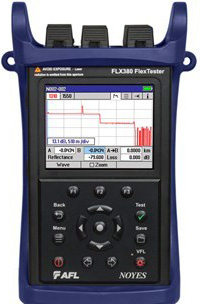
|
|
The NOYES FLX380-103 1310/1550/1625 nm PON-Optimized FlexTester is a small, lightweight, complete single-mode fiber optic test set. It combines high-performance, multi-wavelength OTDR/PON OTDR, OLS, OPM, VFL and PON Power Meter in a rugged, hand-held package. With 41 dB dynamic range, best-in-class event, attenuation, and PON dead zones, and AFL's unique ServiceSafe and Wave ID features, the FLX380-103 FlexTester offers an unmatched combination of optical test functions and ease-of-use. Over 1000 OTDR test results may be saved in industry-standard .SOR file format. Stored OTDR and OPM results may be transferred to PC via USB port for viewing, analysis, and professional report generation using the included Windows compatible Test Results Manager (TRM) software. Specifications. OTDR (Point-to-Point, PON, Live PON); Emitter Type: Laser. Fiber Type: Single-mode. Available Wavelengths: 1310 / 1550 / 1625 nm. Wavelength Tolerance: ±20 / ±20 / ±10 nm. Dynamic Range (SNR=1): 41 / 38 / 37 dB. Event Dead Zone: 0.8 m. Attenuation Dead Zone: 3.5 m. PON Dead Zone: 40 m. Pulse widths: 5, 10, 30, 100, 300 ns; 1, 3, 10, 20 ?s. Range Settings: 250 m to 240 km. Data Points: Up to 30,000. Data Point Spacing: 5.0 cm (range <1.5 km); Range/30,000 (range >1.5 km). Group Index of Refraction: 1.4000 to 1.6000. Distance Uncertainty (m): ± (1 + 0.003% x distance + data point spacing). Linearity: ±0.05 dB/dB. Trace File Format: Bellcore GR-196 v1.1. Trace File Storage Medium: Internal memory (>1000 traces). Data Transfer to PC: USB cable. PON OTDR Modes: FTTx - PON Construction, In Service, Expert. . Optical Laser Source (OLS); Fiber Type: Single-mode. Available Wavelengths: 1310, 1490, 1550 nm. Wavelength Tolerance: ±20 nm. Spectral Width (FWHM): 5 nm (maximum). Internal Modulation: 270 Hz, 330 Hz, 1 kHz, 2 kHz, CW. Output Power Stability: 0.25 dB. Output Power: -1 dBm (1310, 1550 nm) ±1.5 dB; +3 dBm (1490 nm) ±1.5 dB. Optical Power Meter; Calibrated Wavelengths: 1310, 1490, 1550, 1625, 1650 nm. Measurement Range: +23 to -50 dBm. Accuracy: ±0.25 dB. Resolution: 0.01 dB. Visual Fault Locator (VFL): Emitter Type: Visible red laser, 650 ±20 nm. Output Power (nominal): 0.8 mW into single-mode fiber. Modes: CW, 2 Hz flashing. PON Power meter for single-mode only; Calibrated Wavelengths: 1490, 1550 nm. Isolation: >40 dB. Measurement Range: +23 to - 50 dBm. Accuracy: ±0.5 dB. Resolution: 0.01 dB.
|